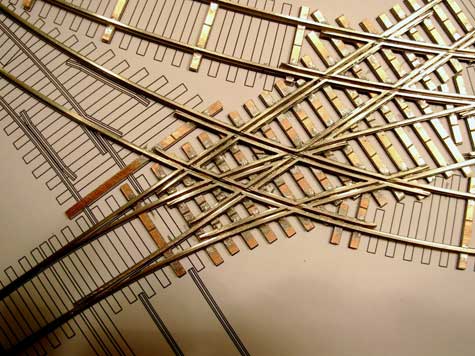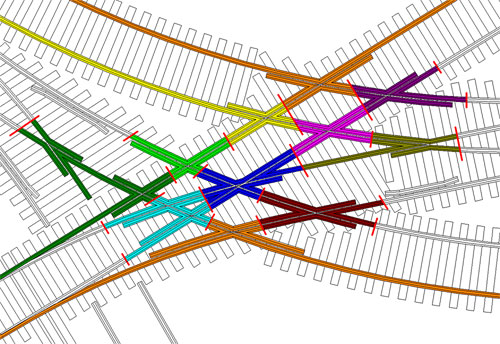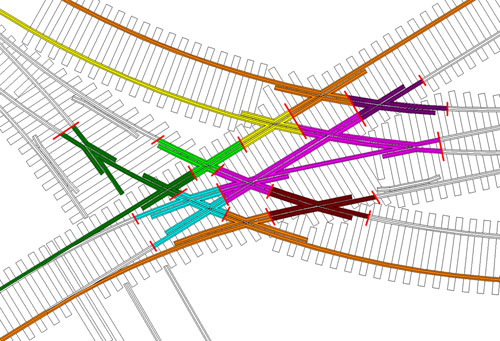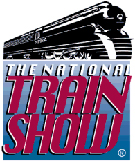Cutting the Gaps
Re-Post
I made a post a some time back about cutting the necessary electrical isolation gaps for the complex trackwork in the terminal. Over time it has gotten buried in the posts and since it is a question that comes up quite often I thought I would re-post it here. I have also created a category on the right hand side of the site called “Cutting Gaps” that will keep this post easily accessible.
The gaps in the PC board ties were all cut with a triangle file. The gaps in the rails are all cut using a jewelers saw. Using a jewelers saw allows the blade to be removed from the saw and slipped between the ties and then re-attached to the saw. The rail is then carefully sliced using a fine blade. This leaves a very thin gap that is almost invisible. Since the rail is soldered to all PC board ties, there is no chance (OK, little chance) that the gaps will ever be able to close up, so no filler is necessary.

Gapping complex trackwork.
The number one thing I get asked about when someone sees this trackwork is “how will you wire this?”. Seeing all those frogs it looks very complex but once you understand the basics of where to isolate sections of track you develop an eye for where to cut the gaps.
I design a lot of complex trackwork and part of the design is determining where modelers will need to cut gaps to have the trackwork operate properly. DC or DCC, the gapping is the same when building ultra-reliable track. To have trackwork (turnouts and crossings) work without shorts or equipment stalling it is necessary to “cut the frogs out”, that is to completely isolate the frog from the rest of the turnout and feed power to the frog independently from the turnout. Power is supplied to the frog from either a switch machines contacts or from a ground throw that has contacts on it.
The link will show a animated rendering showing how this works….
Rendering illustrating switching power to a frog.
The “polarity” of the frog is set to match either the “north” or “south” rail depending on which way the turnout is set. The same is true for multi frog trackwork. Each location where two rails cross each other (frogs) will need to be isolated from the rest of the track and powered independently based on the route selected.

Image Copyright (c) 2007 Tim Warris
What I have illustrated here is all the different frogs in the first section of trackwork I built. The gaps cut through the rails are shown in red. After studying the drawing for a while and thinking how a train would run through the trackwork I determined where each frog would have to be cut using a jewelers saw. (Link to article on this technique)
Power will be fed to each frog from the contacts of switch machines relative to the route selected. Additional contacts will be needed and will be supplied from relays connected to the switch machine contacts.
It isn’t as difficult as it appears, but when complete there will be lots of wires feeding all the different frogs, which does make it appear complex, but in reality it is the same circuit repeated several times. You end up with stuff like this…
But it runs 100% reliably!
-Tim
Gap Update
Oops.
A sharp eyed modeler pointed out a mistake in the gapping in the section shown above. The Blue/Pink/Green frogs can all be a single section, like in the image below….
The logic being that only a single train can travel over the entire pink section at a time, therefore it isn’t necessary to isolate the three frogs, it can be left as a single section.
Thanks to David at The Gauge for pointing this out. It will save a few wires!
-Tim
About the Author:
I'm your host, Tim Warris, a product developer in Port Dover, Ontario. Since March of 2007 I have been documenting the construction of the former CNJ Bronx Terminal in HO scale. For my day job, I design track building tools for Fast Tracks, a small company I own and operate. Fast Tracks makes it fast and easy to hand lay your own trackwork. Stop by our website to learn more!
Posted by: Tim | 01-20-2009 | 10:01 AM
Posted in: Cutting Gaps | Latest Posts





Tim
The blue frog might still need to be gaped, if trains going in oposite directions could pass at point. (ie: loco on the blue frog while a cabose or car or a loco on the purple-green frog going the other way would cause a short.
Jim
Hi Jim,
That’s a good point, and why I had initially had the gaps there. The terminal would only ever have one loco operating at any time, as will the layout, so it isn’t possible to create that situation. This is what David pointed out and I have to agree, the gap, in this configuration isn’t necessary.
Tim
Is that the lead to the bardge loading area? If so, then a car with metal wheels waiting to be moved might still cause that short. You know Murphy is a brakeman at the terminal!!
LOL! BUT– if there is not clearance for two cars to be on the frog at one time, than I agree, no gap needed.
Hope one day to be at a show when you are there also, would be great to see the Bronx in person. By the way, how is the N-guage version progressing. That would be even nicer -to see both side by side.
Jim
Jim
I’d be interested in seeing the wiring diagram for the relays to control power to the frogs. It seems like you would need a selector switch to select only one of the four routes through this junction. Otherwise, trying to route the power from switch machine or ground throw contacts would create a short. Is that right?